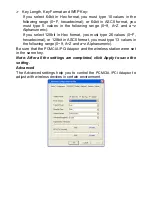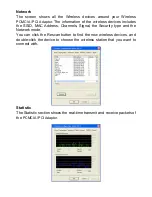
¾
Wireless Mode:
You can check of the wireless modes; 802.11b, 802.11g and
SuperG:
IEEE 802.11b:
checked to support IEEE 802.11b wireless mode, at
this mode the bandwidth is up to 11Mbps.
IEEE 802.11g:
checked to support IEEE 802.11g wireless mode, at
this mode the bandwidth is up to 54Mbps.
SuperG:
checked this mode to support Super-G wireless mode, at
this mode the bandwidth is up to 108Mbps.
¾
Power Saving:
To set your Wireless
PCMCIA /PCI Adapter
as power saving mode,
select “Off”, “Normal” or “Maximum”.
¾
Transmit Power:
By selecting the Transmit Power, you can select the Radio
Frequency output power from Minimum, 12.5%, 25%, 50%, 100% or
Auto.
¾
Preamble Type:
The usage of the preamble is to limit the packet size of the data to
transmit. It is recommended to choose the short preamble when the
link quality is bad, it is to prevent the wasting time of resending a
long packet that is lost. The Default is Auto which access short and
long preamble.
¾
Country Domain:
This is the channel selection of each country regulatory domain,
select the country where you are using this wireless device, users
are responsible for ensuring that the channel set configuration is in
compliance with the regulatory standards of these countries.
¾
eXtended Range(XR):
Enable or Disable the eXtended Range function.
¾
Fragment Threshold:
Fragmentation Threshold is a way of transmitting the packets that
will be fragmented. Choose a setting within a range of 256 to 2432. It
is recommended to fragment the packet when the link quality is bad,
it is to prevent the wasting time of resending a long packet that is
lost.







































